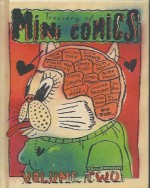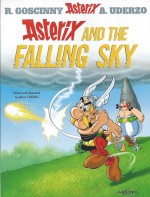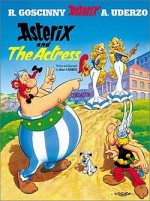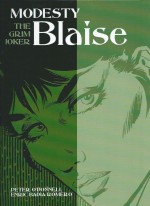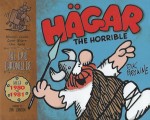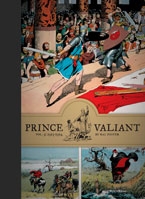
By Hal Foster (Fantagraphics Books)
ISBN: 978-1-60699-735-2
The stellar Sunday page Prince Valiant in the Days of King Arthur debuted on February 13th 1937, a luscious, luminous full-colour weekly window into a miraculous too-perfect past of adventure and romance, even topping creator Hal Foster’s previous endeavour, the astoundingly impossibly popular comics masterpiece Tarzan of the Apes.
The saga of noble knights played against a glamorised, dramatised Dark Ages historical backdrop as it followed the life of a refugee boy driven from his ancestral homeland in Scandinavian Thule who grew up to roam the world and attain a paramount position amongst the heroes of fabled Camelot.
Auteur Foster wove his epic tale over decades, following the progress of a near-feral wild boy who grew into a paragon of chivalric virtue: knight, warrior, saviour, vengeance-taker and eventually family patriarch in a constant deluge of wild – and joyously witty – wonderment.
The restless hero visited many far-flung lands, siring a dynasty of equally puissant heroes and utterly enchanting generations of readers and thousands of creative types in all the arts.
There have been films, an animated series and all manner of toys, games, books and collections based on Prince Valiant – one of the few adventure strips to have run continuously from the thunderous 1930s to the present day (more than 4000 episodes and counting) – and even here at the end times of newspaper narrative cartoons as an art form, it continues to astound in more than 300 American papers. It has even cut its way onto the internet with an online edition.
Foster crafted the feature alone until 1971 when illustrator John Cullen Murphy (Big Ben Bolt) succeeded him as illustrator. Foster continued as writer and designer until 1980, after which he retired and Cullen Murphy’s daughter Mairead took over colouring and lettering whilst her brother John assumed the writer’s role.
In 2004 the senior Cullen Murphy also retired, since when the strip has soldiered on under the auspices of many extremely talented artists such as Gary Gianni, Scott Roberts and latterly Thomas Yeates with Mark Schultz (Xenozoic) superbly scripting. That scribe also provides this volume’s Introduction ‘More Than Pretty Pictures: Storytelling Beyond Genre, Gender, and Medium’ wherein Foster’s extraordinary facility with expressions and pioneering creation of strong and capable female characters is celebrated, analysed and explained by focusing on the artist’s astoundingly able wife and lifemate Helen.
This enormously entertaining and luxurious oversized (362 x 264mm) full-colour hardback reprints the pages from January 4th 1953 to 26th December 1954 (pages #830-933, if you’re counting) but before we proceed…
What Has Gone Before: Having negotiated a truce between Val’s Scandinavian nation Thule and the kingdom of Orkney, the restless Prince undertook his most momentous task yet. Bringing back missionaries from Rome at his father King Aguar‘s request, the rowdy knight of Camelot began overseeing the nation’s slow conversion from Paganism and Druid worship to Christianity.
The job was not without risk with the missionaries and their regal escort (who was still far from a believer in the One God himself) encountering stiff resistance and worse from the Thor-loving populace – and especially their profiteering priests…
The saga resumes with Val and companions Helgi and Torr presiding over a tenuous truce between new and old faiths which is soon threatened after the Prince exposes the seeming “miracles†of the Thor priests for what they truly are. In retaliation the new Christian chapel is burned down, but the missionaries’ stoic acceptance and calm rebuilding impresses the masses far more than all the druids’ tricks and bombast…
Assuming their job completed Valiant and his men depart only to be caught in a terrible forest fire which only two survive…
Struggling home to his family, saddened Val monopolises all his wife’s attention and jealous first born son Arn acts up by leaving home to have adventures of his own. The little lad takes with him a hound of dubious pedigree and ancestry – dubbed Sir Gawain – and has a grand old time. Before true peril can threaten however the wanderers encounter an old friend of Valiant’s: another Round Table knight who is less than pleased to learn that he shares his noble name with a mangy, flea-bitten mutt…
A pleasant time of gentle recuperation amongst friends is capped by another birth as Aleta’s Amerindian maid Tillicum produces a first son for her Viking husband Boltar but marred by separation as Valiant’s wife is called back to her own kingdom in the Misty Isles to quell a rebellion. He is unable to join her when Gawain’s mission is revealed: the Danes and Saxons have invaded Britain in a vast army with unbeatable new battle tactics and now lay siege to Camelot itself…
Assured by Aleta that she can handle her crisis, Valiant and Gawain take ship and soon rejoin Arthur at Tintagel. The troubled monarch has learned that five kings of Cornwall are planning to ally with the invader Horsa and hopes the devious mind of the Prince of Thule can again trump overwhelming odds with keen wits and courage…
The campaign begins as Val impersonates a troubadour and sows treachery and dissent amongst the new allies. Soon one Celtic king is dead and the remaining quartet are frantically realigning with Arthur. With the defenders now united against the Saxons the long campaign to repulse them begins and once more the Prince’s unique and imaginative grasp of unconventional warfare is the defenders’ greatest asset…
With the tide turning, Val is surprised to be ordered away from battle to undertake another impossible task. Throughout Arthur’s reign the realm had periodically suffered raids from Ireland. Now they are a distraction England cannot afford and Valiant is despatched to the Emerald Isle to secure peace.
He has no idea how to accomplish the task but dutifully sails off, and gets into a fight as soon as he touches ground again. Happily his brawl with local chieftain Brian O’Curry impresses everyone so much that the boisterous hulking brute proclaims him a friend for life.
Soon they are travelling to capital outpost Cashel to meet current and pro tem overlord Rory McColm, but the journey is delayed as Brian’s clan encounters and has a quick war with a rival tribe. As Val learns from keenly observing holy man and Christian missionary Patrick, there’s nothing the Irish love more than fighting…
That also proves true when the visitor is finally granted an audience with the cruelly arrogant McColm, who spurns Britain’s entreaties and insults the infamously hot-headed Prince of Thule. Before long diplomacy is abandoned and a furious duel ensues. After Val ends all hopes of Rory’s retaining his crown – by defeating and mildly maiming him – the visitor becomes a harried fugitive running for his life…
With Brian and Patrick’s assistance Valiant escapes Ireland and heads for home where he meets Merlin who has an important prognostication for Arthur. Unfortunately before he can completely reveal it the aged mage is whisked away by enchanting temptress Nimue, leaving Valiant with nothing but frustrating fragments of a vital warning…
Rejoining the king as he struggles against the entrenched Saxons in Kent, Valiant finally deciphers the truncated message and goes about orchestrating the invaders’ ultimate defeat. The crucial first step is to allow himself to be captured and tortured by Horsa’s forces…
The scheme works perfectly and as deep snows give way to spring the crushed and starving enemy are driven from Britain’s shores, allowing the wily tactician time to wonder how his wife fares in sunnier climes. He is eager to join her but sworn companion Gawain has fallen in love with the wrong maiden – again – and by the time the affair ends all he has to show for it is a new, exceedingly homely, inept yet oddly effective servant dubbed Pierre…
When Aleta arrived in the Misty Isles with her three children she found her sister and regent Helene increasingly under the sway of her husband Dionseus. The cagy thug had visions of turning the prosperous and peaceful trading nation into a piratical kingdom raiding and conquering the region. To achieve his aims he had slowly infiltrated the government, padding it with his cronies.
He has no idea of Aleta’s incomparable political acumen and astute manoeuvrings and, after failing to poison her and her heirs, somehow finds himself and all his mercenaries banished without a drop of blood being shed…
Humiliated and infuriated, Dionseus retrenches and begins planning his murderous return at the head of an invasion fleet, just as Valiant and Gawain finally arrive in the Misty Isles. Aleta, delighted to see them, has matters well in hand and prefers that they hang back and let her handle matters her way.
The Queen is grateful however for information provided by Pierre who, after a night of low carousing with servants in town, uncovers a plot by a coterie of nobles who plan to betray her for advancement in Dionseus’ men-only regime…
Eventually, outthought and overmatched in every way, the usurper is utterly defeated and bored Valiant grows even more restless as Aleta sets to reforming her kingdom so that such a coup can never threaten again.
After tedium leads to a ferocious domestic spat the Prince and Gawain resolve to get out of everyone’s hair and go on a pilgrimage to Jerusalem. Of course, no sooner have they arrived in the Holy City than they find themselves in hot water after seeing the plight of a Christian knight.
Thanks to another drunken debauch by Pierre the sly truth is soon revealed. Sir Basil has been held in an impenetrable but easily observed dungeon for a decade: an unwilling Judas Goat used by Sheik Ben El Rasch to trap European knights who would attempt to rescue their fellow and fall captive to a master of the art of ransoming.
The soon to depart occupying garrison of Roman soldiers are too busy preparing for their withdrawal to bother themselves with strictly local affairs so the Sheik has grown rich trading on the good intentions of noble Christian pilgrims and warriors, but now, forewarned, Valiant and Gawain are resolved to teach him a lesson he will never forget…
Sadly they succeed all too well and taking El Rasch hostage leads to them being approached by his deadliest enemies who wish to buy him! Baulking at such barbarism but stalling until they have freed Sir Basil, the Round Table heroes thus incur the wrath of Syrian tribesmen too, but undaunted determine to finish their pilgrimage.
The decade-delayed Basil is eager to join them, but on every step of the quest they are pursued by two furious rival desert factions as keen to kill them as each other…
Although implacable and numerous, the burnoosed hunters have never encountered fighters as cunning, imaginative and skilled as Valiant and his companions. Despite their best efforts – and even the seductive eyes of El Rasch’s daughter – the questors complete their journey and safely head back to the Misty Isles…
During their absence little Arn has grown old enough to notice girls and he does not like them. He and noble playmate Paul make an exception for kitchen-gamin Diane however, since she can sneak them out of the palace, teach them to fish and outfight them both.
When she subsequently saves their lives, Aleta neatly sidesteps all manner of court scandal and disapprobation by declaring her to be for a full year, a royal companion and a boy…
Everything seems spoiled though after the pilgrims return and the lad Diane develops a crush on Gawain. The legendary lover is deeply mortified by the sprite’s attention, but when a palace lothario attempts to get rid of Valiant and pursue the queen, Gawain steps in to defend her honour and is grateful for bold Diane’s help in avoiding a treacherous trap…
Soon however dull peace breaks out once more and before Val and his brother knight can ruin it again Aleta decrees it’s time for the royal family to head North once again…
To Be Continued…
Closing this astonishing epic of daring-dare-deviltry, Brian M. Kane scrutinises in searing detail the history of film and TV iterations in ‘Prince Valiant and the Sacking of Hollywood: The 60th Anniversary of Hal Foster’s Creation on the Silver Screen’, featuring the apparently accursed 1954 movie and Foster’s subsequent starring role on This Is Your Life as well as the 1997 international film remake and animated series The Legend of Prince Valiant
Rendered in a simply stunning panorama of glowing visual passion and precision, Prince Valiant is a non-stop rollercoaster of boisterous action, exotic adventure and grand romance; blending human-scaled fantasy with dry wit and broad humour, soap opera melodrama with shatteringly dark violence.
Beautiful, captivating and utterly awe-inspiring, the strip is a true landmark of comics fiction and something no fan should miss.
© 2014 King Features Syndicate. All other content and properties © 2014 their respective creators or holders. This edition © 2014 Fantagraphics Books. All rights reserved.



